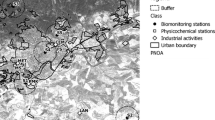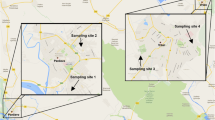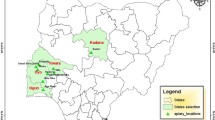Abstract
Nectar of honeybee colonies has been used in order to identify heavy metals and establish the benefit of this type of studies as a tool for environmental management. For these goals, samples of nectar were obtained from Apis mellifera hives placed in the city of Córdoba (Spain) and its surroundings. Five stations (each with two hives) were selected and samples were collected from May to July of 2007, 2009 and 2010. Concentrations of Pb, Cr, Ni and Cd in nectar were determined by graphite furnace atomic absorption spectrophotometry. Substantial spatial and temporal differences were detected and compared with the values found in bee bodies in a previously published study based on samples obtained simultaneously with those presented in this work. Upper reference thresholds established for this investigation were surpassed frequently by the measures obtained, being Cr (21.43% of samples), stations S3 (22.22%) and S4 (11.12%) year 2009 (22.22%) and the month of July (23.68%) the metal, the locations and the periods that exceeded more times these references. Regarding the Cd, which was studied only in 2010, 33.33% of the nectar samples exceeded the upper reference thresholds. Comparing the biomonitoring of bee bodies and nectar, some coincidences were found, although they showed different results for highest worrisome values of metal, station and year. This suggests that both methods can give complementary information in the surveillance systems of atmospheric pollution.










Similar content being viewed by others
References
AECOSAN Spanish Agency of Consumption, Food Security and Nutrition (n.d.) Heavy metals. http://www.aesan.mspsi.gob.es/AESAN/web/cadena_alimentaria/subdetalle/qui_metales_pesados.shtml. Accessed 7 February 2012 (in Spanish)
Balestra V, Celli G, Porrini C (1992) Bees, honey, larvae and pollen in biomonitoring of atmospheric pollution. Aerobiologia 8:122–126
Barišić D, Vertačnik A, Bromenshenk JJ, Kezić N, Lulić S, Hus M, Kraljević P, Šimpraga M, Seletković Z (1999) Radionuclides and select elements in soil and honey from Gorski Kotar, Croatia. Apidologie 30:277–287
Bettinelli M, Terni C (2000) Determination of trace elements in honey by ICP-MS. In: Minoia C, Bettinelli M, Ronchi A, Spezia S (eds) Application of ICP-MS in chemical and toxicological laboratory. Morgan, Milán, pp 341–349
Bibi S, Husain SZ, Malik RN (2008) Pollen analysis and heavy metal detection in honey samples from seven selected countries. Pak J Bot 40:507–516
Bogdanov S (2006) Contaminants of bee products. Apidologie 37:1–18
Bogdanov S, Haldimann M, Luginbühl W, Gallmann P (2007) Minerals in honey: environmental, geographical and botanical aspects. J Apicult Res 46:269–275
Boquete L, Barea R, Rodríguez JM, Fando R, Cuervo G, Fernández B, Tordera L, de Diego M, Gómez M, Parra I (2013) Environment and sensorization. City 2020: towards a new model of intelligent and sustainable city, IPT 20111006 (in Spanish)
Boyd R (2009) High-nickel insects and nickel hyperaccumulator plants: a review. Insect Sci 16:19–31
Boyd R (2010) Heavy metal pollutants and chemical ecology: exploring new frontiers. J Chem Ecol 36:46–58
Bromenshenk JJ (1986) Public participation in environmental monitoring: a means of attaining networks capability. Environ Monit Assess 6:35–47
Byrne D (2000) Amending Annex II to Council directive 92/118/EEC b (draft)
Celli G, Maccagnani B (2003) Honey bees as bioindicators of environmental pollution. B Insectol 56:137–139
Chicas-Mosier CBA, Melendez AM, Perez M, Abramson CI (2017) The effects of ingested aqueous aluminum on floral fidelity and foraging strategy in honey bees (Apis mellifera). Ecotoxicol Environ Saf 143:80–86
Conti ME, Botrè F (2001) Honeybees and their products as potential bioindicators of heavy metals contamination. Environ Monit Assess 69:267–282
Devillers J, Pham-Delègue MH (2002) Honeybees: estimate the environmental impact of chemicals. Taylor & Francis, London and New York
EC (2005) Directive 2004/107/EC of the European Parliament and of the Council of 15 December 2004 relating to arsenic, cadmium, mercury, nickel and polycyclic aromatic hydrocarbons in ambient air. DO L 23 of 26.1.2005, p. 3–16
EC (2008) Directive 2008/50/EC of the European Parliament and of the Council of 21 May 2008 on ambient air quality and cleaner air for Europe. DO L 152 of 11.6.2008, p. 1–44
EC (2010) Directive 2010/75/EC of the European Parliament and of the Council of 24 November 2010 on industrial emissions (integrated pollution prevention and control). DO L 334 of 17.12.2010, p. 17–19
EC (2015) Commission Regulation (EU) 2015/1005 of 25 June 2015 amending Regulation (EC) No 1881/2006 as regards maximum levels of lead in certain foodstuffs. DO L 161 of 26.6.2015, p. 9–13
EEA European Environment Agency (2013) Air quality in Europe – report 2012. Ministry of Agriculture, Food and Environment, Madrid, p 104 (in Spanish)
Gall J, Boyd RS, Rajakaruna N (2015) Transfer of heavy metals through terrestrial food webs: a review. Environ Monit Assess 187:200–221
Garty J (2002) Biomonitoring heavy metals pollution with lichens. In: Kranner IC, Beckett RP, Varma AK (eds) Protocols in lichenology. Culturing, biochemistry, ecophysiology and use in biomonitoring. Springer, New York, pp 458–482
Giglio A, Ammendola A, Battistella S, Naccarato A, Pallavicini A, Simeon E, Tagarelli A, Giulianini PG (2017) Apis mellifera ligustica, Spinola 1806 as bioindicator for detecting environmental contamination: a preliminary study of heavy metal pollution in Trieste, Italy. Environ Sci Pol R24:659–665
Gnes A, Rondinini T, Pari E, Fonti P, Vincenzi D, Speranza A, Calzoni GL (2004) Mason bees and environment. Insect Social Life 5:111–116
Gutiérrez M, Molero R, Gaju M, Van der Steen J, Porrini C, Ruiz JA (2015) Assessment of heavy metal pollution in Córdoba (Spain) by biomonitoring foraging honeybee. Environ Monit Assess 187:651–665
Hamilton EI (1995) State of the art of trace element determinations in plant matrices: determination of the chemical elements in plant matrices, an overview. Sci Total Environ 176:3–14
Herrero C, Barciela J, García S, Pena RM (2017) The use of honeybees and honey as environmental bioindicators for metals and radionuclides: a review. Environ Rev 25:463–480
Jaishankar M, Tseten T, Anbalagan N, Mathew BB, Beeregowda KN (2014) Toxicity, mechanism and health effects of some heavy metal. Interdiscip Toxicol 7(2):60–72
Järup L (2003) Hazards of heavy metal contamination. Br Med Bull 68:167–182
Jones KC (1987) Honey as an indicator of heavy metal contamination. Water Air Soil Pollut 33:179–189
Kalbande DM, Dhadse SN, Chaudhari PR, Wate SR (2008) Biomonitoring of heavy metals by pollen in urban environment. Environ Monit Assess 138:233–238
Klumpp A, Klumpp G (eds) (2004) European network for the assessment of air quality by the use of bioindicator plants (Eurobionet). Final report. University of Hohenheim, Stuttgart
Lambert O, Piroux M, Puyo S, Thorin C, Larhantec M, Delbac F, Pouliquen H (2012) Bees, honey and pollen as sentinels for lead environmental contamination. Environ Pollut 170:254–259
Leita L, Muhlbachova G, Cesco S, Barbattini R, Mondini C (1996) Investigation of the use of honey bees and honey bee products to assess heavy metals contamination. Environ Monit Assess 43:1–9
Meindl GA, Ashman T (2013) The effects of aluminum and nickel in nectar on the foraging behaviour of bumblebees. Environ Pollut 177:78–81
Nicolson SW, Thornburg RW (2007) Nectar chemistry. Nectar chemistry. In: Nicolson SW, Nepi M, Pacini E (eds) Nectaries and nectar. Springer, Dordrecht, pp 215–264
Ordóñez JM, Iriso A, Aránguez E (2007) Proposal for surveillance of the exposure to environmental chemicals in the Spanish population (biomonitoring). http://www.msssi.gob.es/ciudadanos/saludAmbLaboral/docs/Biomonitorizacion.pdf. Accessed 30 November 2011. (in Spanish)
Perugini M, Manera M, Grotta L, Abete MC, Tarasco R, Amorena M (2011) Heavy metal (Hg, Cr, Cd and Pb) contamination in urban areas and wildlife reserves: honeybees as bioindicators. Biol Trace Elem Res 140:170–176
Porrini C, Ghini S, Girotti S, Sabatini AG, Gattavecchia E, Celli G (2002) Use of honey bees as bioindicators of environmental pollution in Italy. In: Devillers J, Pham-Delègue MH (eds) Honeybees: estimate the environmental impact of chemicals. Taylor & Francis, London and New York, pp 186–247
Porrini C, Sabatini AG, Girotti S, Ghini S, Medrzycki P, Grillenzoni F, Bortolotti L, Gattavecchia E, Celli G (2003) Honey bees and bee products as monitors of the environmental contamination. Apiacta 38:63–70
Querol X (2008) Air quality, suspended particles and metals. Rev Esp Salud Public 82:447–454 (in Spanish)
Roman A (2009) Concentration of chosen trace elements of toxic properties in bee pollen loads. Pol J Environ Stud 18:265–272
Roman A (2010) Levels of copper, selenium, lead, and cadmium in forager bees. Pol J Environ Stud 19:663–669
Ruiz JA, Gutiérrez M, Porrini C (2013) Biomonitoring of bees as bioindicators. Bee World 90:61–63
Ruschioni S, Riolo P, Minuz RL, Stefano M, Cannella M, Porrini C, Isidoro N (2013) Biomonitoring with honeybees of heavy metals and pesticides in nature reserves of the Marche region (Italy). Biol Trace Elem Res 154:226–233
Satta A, Verdinelli M, Ruiu L, Buffa F, Salis S, Sassu A, Floris I (2012) Combination of beehive matrices analysis and ant biodiversity to study heavy metal pollution impact in a post-mining area (Sardinia, Italy). Environ Sci Pollut Res Int 19:3977–3988
Serra-Bonvehí J, Orantes FJ (2013) Element content of propolis collected from different areas of south Spain. Environ Monit Assess 185:6035–6047
Spain (2011) Royal Decree 102/2011, of January 28, on improving air quality. Boletín Oficial del Estado (BOE) n° 25, sec. I pp. 9574–9626 (in Spanish)
Tchounwou PB, Yedjou CG, Patlolla AK, Sutton DJ (2012) Heavy metals toxicity and the environment. Exp Suppl 101:133–164
Tuzen M, Silici S, Mendil D, Soyla M (2007) Trace element levels in honeys from different regions of Turkey. Food Chem 103:325–330
US-EPA U.S. Environmental Protection Agency (2007) Graphite furnace atomic absorption spectrophotometry - method 7010 2007
Van der Steen JJM, de Kraker J, Grotenhuis T (2012) Spatial and temporal variation of metal concentrations in adult honeybees (Apis mellifera L.). Environ Monit Assess 184:4119–4126
Van der Steen JJM, de Kraker J, Grotenhuis T (2015) Assessment of the potential of honeybees (Apis mellifera L.) in biomonitoring of air pollution by cadmium, lead and vanadium. J Environ Prot 6:96–102
Zugravu CA, Parvu M, Patrascu D, Stoian A (2009) Correlations between lead and cadmium pollution of honey and environmental heavy metal presence in two Romanian counties. Bulletin UASVM Agriculture 66:230–233
Acknowledgements
We thank José Carlos Casas, from Statistics Department of University of Córdoba, for his advice in the statistical interpretation of results.
Funding
This study has been supported by the Córdoba City Council through the “Evaluation of urban pollution in the municipality of Córdoba using colonies of Apis mellifera as environmental bioindicators” project (Ref: 2006/000228) and by the Spanish Ministry of Environment through the project entitled “Network of biomonitoring stations using colonies of Apis mellifera for real time assessment of urban pollution in the city of Córdoba” (PC 199-003, 2008–2011).
Author information
Authors and Affiliations
Corresponding author
Additional information
Responsible editor: Philippe Garrigues
Publisher’s note
Springer Nature remains neutral with regard to jurisdictional claims in published maps and institutional affiliations.
Rights and permissions
About this article
Cite this article
Gutiérrez, M., Molero, R., Gaju, M. et al. Assessing heavy metal pollution by biomonitoring honeybee nectar in Córdoba (Spain). Environ Sci Pollut Res 27, 10436–10448 (2020). https://doi.org/10.1007/s11356-019-07485-w
Received:
Accepted:
Published:
Issue Date:
DOI: https://doi.org/10.1007/s11356-019-07485-w




